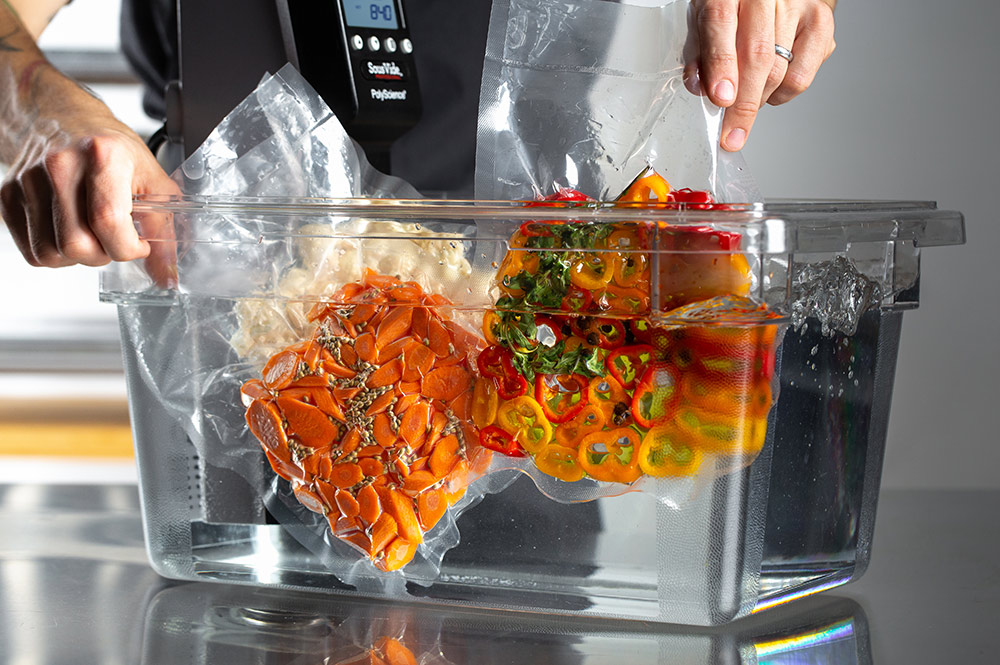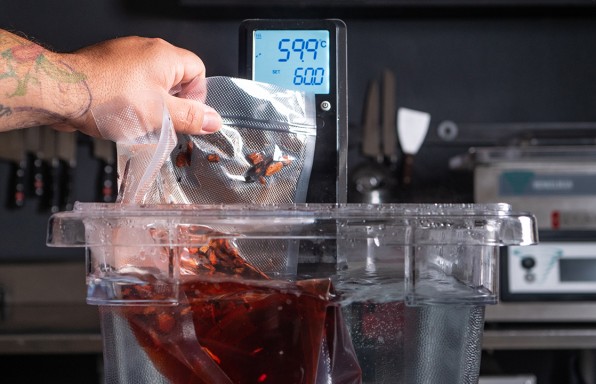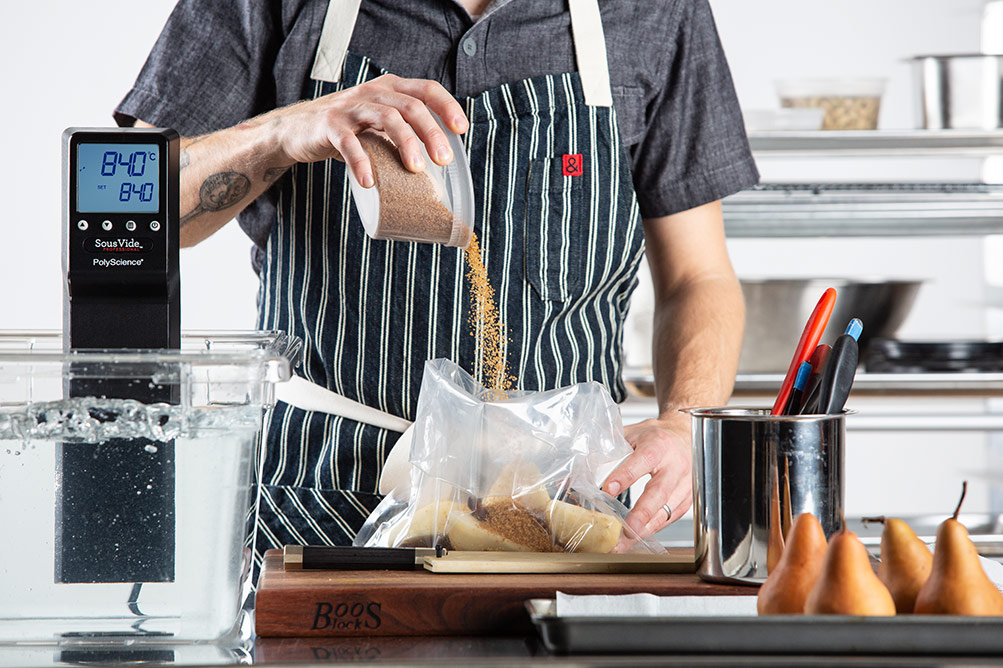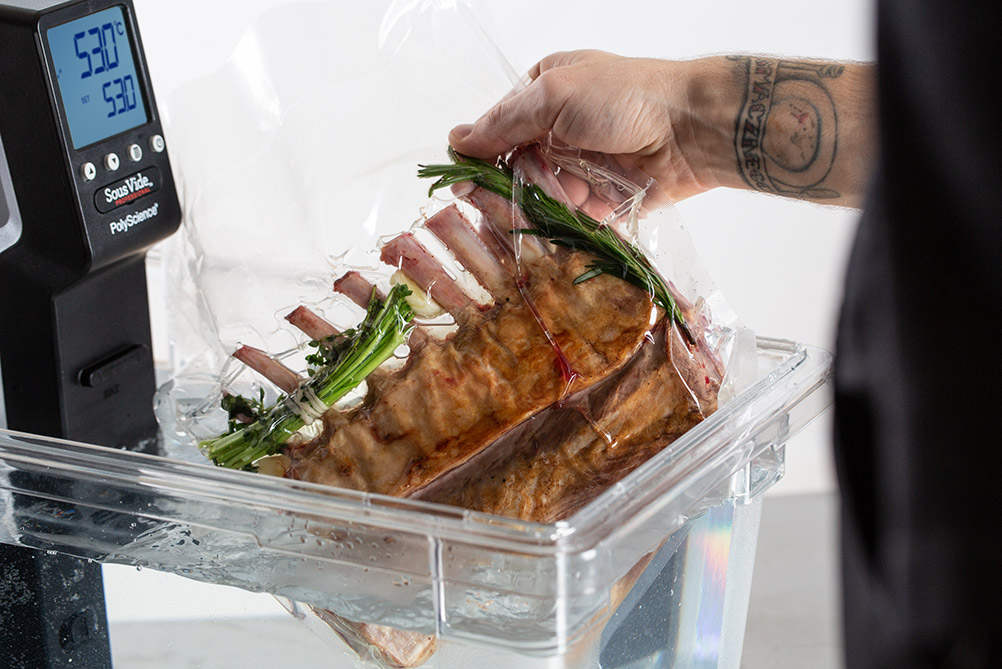Sous Vide literally translates as “under vacuum”.
However, the technique consists of both vacuum cooking and low-temperature cooking.
You can also view vacuum sealing as a process called “Reduced Oxygen Packaging or ROP” – or “Modified Atmosphere Packaging or MAP”.
Although not everyone uses reduced oxygen for low-temperature cooking, there are numerous reasons why vacuum packaging is ideal.

– Vacuum-sealed bags conform tightly to the shape of the product in the bag, providing optimal heat transfer.
– Chamber vacuum packers are able to pack food efficiently and consistently.
– The vacuum bags are airtight, which facilitates the cooling of packaged and cooked food.
– Vacuum bags containing liquids can be frozen flat to optimise storage space and makes inventory control much easier than when working with random items.
– If the food has been cooked and pasteurised sous vide, the shelf life is greatly extended, as the bags are not permeable to oxygen and maintain a low bacterial environment.
– By cooking in a sealed environment, nutrients are not lost in the cooking medium. This also means that volatile aromas and flavours are preserved.

Let’s review some of the best practices when using a vacuum sealing chamber:
Consult your manufacturer for detailed information on this subject.
In our experience, many problems related to faulty vacuum sealers are due to lack of maintenance.
Routinely check and change oil and vacuum filter as necessary.
Continuously check other wear items such as the sealing bar tape and wires or the cover channel gasket.
Only vacuum seal the product if the internal core temperature is 41ºF or below.
The reason for this is that as the pressure in the vacuum chamber approaches zero millibars, the boiling point is reduced.
The liquids in the bag will start to boil when this happens.
This means that the water content inside the food will also start to boil.
In the case of products such as tomato sauce, this action need not be detrimental to the food product, but can create a mess.
On the other hand, the cell membrane of products such as fish fillets, steaks or other animal protein cuts will rupture and lose its ability to retain moisture as the food cooks.
The result will be a dry food with an unpleasant texture.

When vacuum sealing products, whether fillets or sliced carrots, ensure that the product is in a single uniform layer.
This will ensure that the product is cooked evenly.
You can pack several chicken breasts in a single bag, but lay them flat, do not stack them.
Overfilling bags with liquid or not using a liquid tray when sealing can cause the bags to spill.
This could lead to moisture leakage into internal components, resulting in costly repairs.
When filling a vacuum bag with seasonings, be careful not to clog the sealing area with salt or spice granules.
Most vacuum sealers push condiments out of the way when sealing, but solids such as spices will clog the seal, possibly causing the bag to leak.

Vacuum bags can vary in thickness and material composition.
Folding a bag to keep the sealing area clean may cause micro-cracks in the bag leading to leakage.
Some bags are more resistant to this than others, but as best practice do not fold the bag.
Aromatics such as citrus peel, whole garlic and herbs can leave an imprint on the food you are cooking.
Use enough oil in your bag so that these aromatics can move freely without touching the food, or prepare a powerful, aromatic oil that is infused with flavour.

TÖUFOOD is a complete line of products of exceptional quality, developed by GASTROCULTURA MEDITERRÁNEA SL, which allows the most well-known techniques of modern cuisine to be put into practice. Innovative recipes can be easily realised, bringing excitement and surprise to dishes, offering a stimulating and memorable culinary experience.